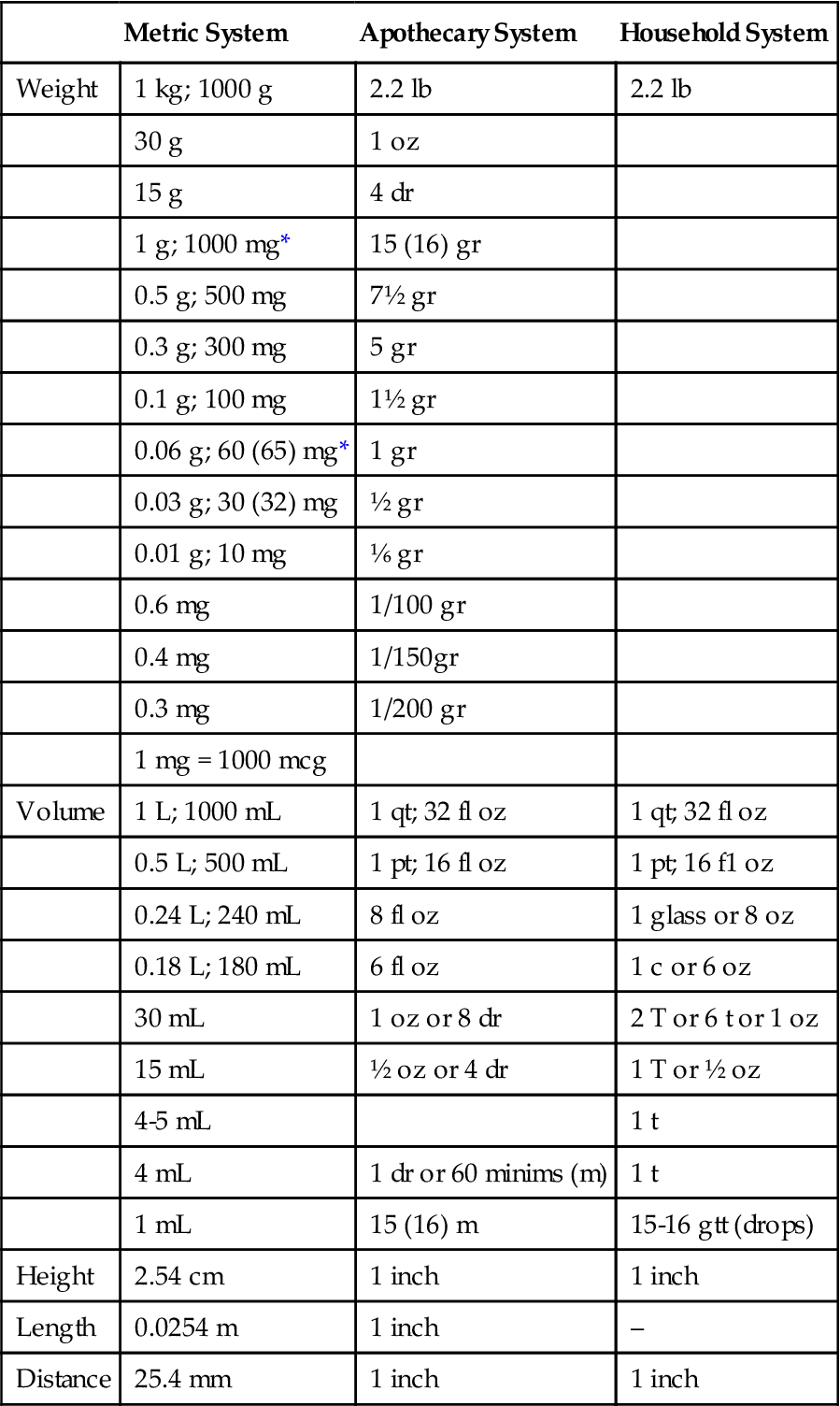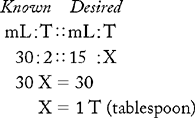CONVERSION WITHIN THE METRIC, APOTHECARY, AND HOUSEHOLD SYSTEMS
Objectives
• Convert grams/milligrams and milligrams to grams.
• Convert drug dosage by weight from one system to another system by using the ratio method.
• Utilizes the conversion table for metric, apothecary, and household systems.
• Convert liters/milliliters to ounces and milliliters to tablespoons and teaspoons.
Today, conversion within the metric system is more common than conversion within the metric- apothecary systems. Although the apothecary system is being phased out, some physicians still order drug dosages by apothecary units. If the faculty find that the apothecary system is not being used in their institutions, they may wish to omit the apothecary equivalents and conversion shown in Table 2-1.
TABLE 2-1
Approximate Metric, Apothecary, and Household Equivalents
| Metric System | Apothecary System | Household System | |
| Weight | 1 kg; 1000 g | 2.2 lb | 2.2 lb |
| 30 g | 1 oz | ||
| 15 g | 4 dr | ||
| 1 g; 1000 mg* | 15 (16) gr | ||
| 0.5 g; 500 mg | 7½ gr | ||
| 0.3 g; 300 mg | 5 gr | ||
| 0.1 g; 100 mg | 1½ gr | ||
| 0.06 g; 60 (65) mg* | 1 gr | ||
| 0.03 g; 30 (32) mg | ½ gr | ||
| 0.01 g; 10 mg | ⅙ gr | ||
| 0.6 mg | 1/100 gr | ||
| 0.4 mg | 1/150gr | ||
| 0.3 mg | 1/200 gr | ||
| 1 mg = 1000 mcg | |||
| Volume | 1 L; 1000 mL | 1 qt; 32 fl oz | 1 qt; 32 fl oz |
| 0.5 L; 500 mL | 1 pt; 16 fl oz | 1 pt; 16 f1 oz | |
| 0.24 L; 240 mL | 8 fl oz | 1 glass or 8 oz | |
| 0.18 L; 180 mL | 6 fl oz | 1 c or 6 oz | |
| 30 mL | 1 oz or 8 dr | 2 T or 6 t or 1 oz | |
| 15 mL | ½ oz or 4 dr | 1 T or ½ oz | |
| 4-5 mL | 1 t | ||
| 4 mL | 1 dr or 60 minims (m) | 1 t | |
| 1 mL | 15 (16) m | 15-16 gtt (drops) | |
| Height | 2.54 cm | 1 inch | 1 inch |
| Length | 0.0254 m | 1 inch | – |
| Distance | 25.4 mm | 1 inch | 1 inch |

*Equivalents commonly used for computing conversion problems by ratio.
Drug doses are usually ordered in metric units (grams, milligrams, liters, and milliliters). To calculate a drug dosage, the same unit of measurement must be used. Therefore, you must memorize the metric equivalents. After the conversion is made, the dosage problem can be solved. Some authorities state that it is easier to convert to the unit used on the container (bottle).
Dosage conversion tables are available in many institutions; however, when you need a conversion table, one might not be available. Nurses should memorize metric equivalents or should be able to convert within the system.
UNITS, MILLIEQUIVALENTS, AND PERCENTS
Units, milliequivalents, and percents are measurements and are used to indicate the strength or potency of certain drugs. When a drug is developed, its strength is based on chemical assay or biological assay. Chemical assay denotes strength by weight, e.g., milligrams or grains. Biological assays are used for drugs in which the chemical composition is difficult to determine. Biological assays assess potency by determining the effect that one unit of the drug can have on a laboratory animal. Units mainly measure the potency of hormones, vitamins, anticoagulants, and some antibiotics. Drugs that were once standardized by units and were later synthesized to their chemical composition may still retain units as an indication of potency, e.g., insulin.
Milliequivalents measure the strength of an ion concentration. Ions are given primarily for electrolyte replacement. They are measured in milliequivalents (mEq), one of which is  of the equivalent weight of an ion. Potassium chloride (KCl) is a common electrolyte replacement and is ordered in milliequivalents.
of the equivalent weight of an ion. Potassium chloride (KCl) is a common electrolyte replacement and is ordered in milliequivalents.
Percents, the concentrations of weight dissolved in a volume, are always expressed as units of mass per units of volume. Common concentrations are g/mL, g/L, and mg/mL. These concentrations, expressed as percentages, are based on the definition of a 1% solution as 1 g of a drug in 100 mL of solution. Dextrose 50% in a 50-mL pre-filled syringe is a concentration of 50 g of dextrose in 100 mL of water. Calcium gluconate 10% in a 30-mL bottle is a concentration of 10 g of calcium gluconate in 100 mL of solution. Proportions can also express concentrations. A solution that is 1:100 has the same concentration as a 1% solution. Epinephrine 1:1000 means that 1 g of epinephrine was dissolved in a 1000-mL solution.
Units, milliequivalents, and percents cannot be directly converted into the metric, apothecary, or household system.
METRIC, APOTHECARY, AND HOUSEHOLD EQUIVALENTS
Knowing how to convert drug doses among the systems of measurement is essential in the clinical setting. In discharge teaching for individuals receiving liquid medication, converting metric to household measurement may be important.
Table 2-1 gives the metric and apothecary equivalents by weight and the metric, apothecary, and household equivalents by volume.
Remember, conversion from one system to another is an approximation. Though the apothecary system is not or infrequently used, the table is included as a reference for approximate metric, apothecary, and household equivalents.
 I CONVERSION BY WEIGHT
I CONVERSION BY WEIGHT






